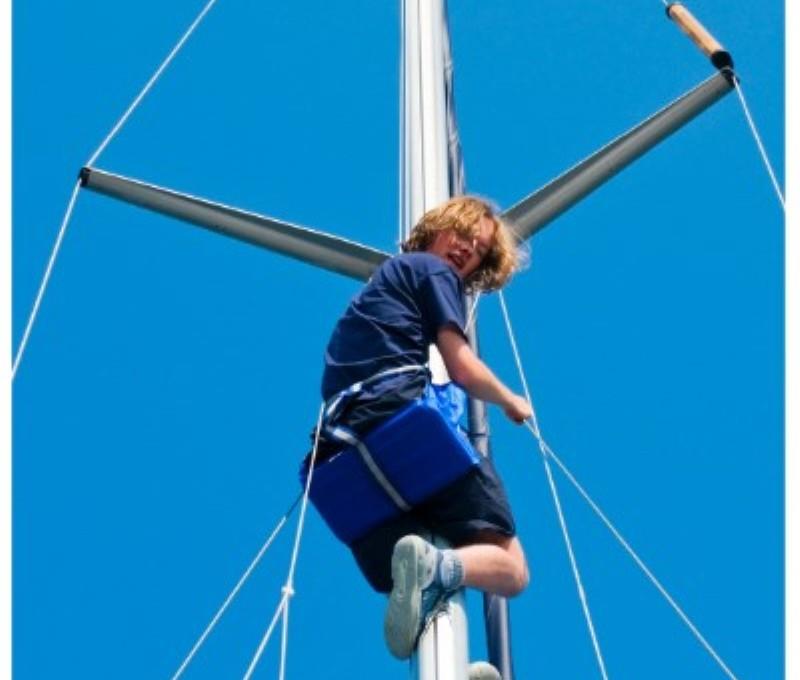
Paranoid or prudent?
by John Hembrow, Island Cruising NZ 4 Mar 06:25 UTC

Ascending the mast © Island Cruising NZ
The prospect of ascending the mast is not something that I look forward to.
It's not that I have a fear of heights. I like being up there and taking in the view. It's the going up and coming down part I don't like. I think my dislike of the ascent and descent part of the exercise results from my tendency to overthink things, resulting in my becoming concerned about what can go wrong. Paranoid or Prudent? Regardless of the verdict, going up the mast is a task that most of us will have to undertake at one time or another, so how do we minimise the risks?
Proactive vs. reactive
It is no secret that I am a BIG FAN of preventative maintenance. In the case of all the stuff attached to or associated with the mast, halyards, pulleys etc., regular inspection and servicing of these items is essential and will likely save you from making an unplanned ascent of the mast. How regular?
I guess that depends on how much use they get. When we are doing lots of ocean miles each and frequently raising, lowering and reefing sails, all the items that move in the process need a more frequent inspection for signs of wear or damage. The same goes with the standing rigging. So that means that we need to ascend and descend the mast more often to carry out more frequent inspections.
Complacency through familiarity
The more often we do something, the more often we are exposed to the risks associated with doing it. However, doing something often usually leads to becoming more confident about it, but it can also lead to complacency. Complacency is what will likely lead to injury or worse!
Injuries and fatalities are more common than you might think
Just google 'sailor falls from mast... If you do, you will find an article on the Sail-World website, "Another mast-climbing death - Nine Rules so you are not next...". Despite having been written several years, this article is still relevant, and the suggestions made in the article are valid to this day.
In summary, the suggestions from the article are:
1. Always use a bosun's chair.
2. Always use a safety line.
3. Wear shoes.
4. Have a separate tool bag.
5. Take up a third light line to hoist and lower tools.
6. Hoist and lower the person ascending/descending the mast slowly & at a consistent speed.
7. Stay clear below. To avoid injury from any dropped tools or items.
8. Wear a harness.
9. Go up the mast and check the gear in the marina before an ocean voyage.
I also suggest adding the following to the above:
- Attach the safety line (2nd halyard) to the harness and not the bosun's chair. If the chair or the chair attachments point fail, the person aloft is still attached to the safety line via the harness.
- Avoid jerky stop-start winching of the halyard attached to the bosun's chair.
- Thoroughly inspect the bosun's chair, particularly the attachment point and the stitching, before going aloft.
- The person going up the mast & the person below them should wear a suitably rated safety helmet.
- The person going up the mast & the person doing the hoisting should wear gloves.
- If ascending the mast at sea or even in an anchorage subject to swell or other vessel wakes, attach yourself to the mast to avoid being swung around when the vessel moves.
- Headsets, a.k.a; marriage savers, are a great help when communicating between the person going aloft and the person on deck, especially if it is windy.
- When carrying out your inspection, take a camera. When you do your initial inspection, take lots of photos of everything and save them so that the next time you do an inspection and see something that doesn't look right, you can photograph it and then compare what you are seeing now to what it looked like before. This also can help to identify replacement parts. It also makes it easy to send the photo to a professional and show them what you are concerned about. There is also the opportunity to get some cool pictures of the boat and your surroundings while you are up there!
- Purchase a quality Bosuns Chair.
- Purchase a quality Safety Harness.